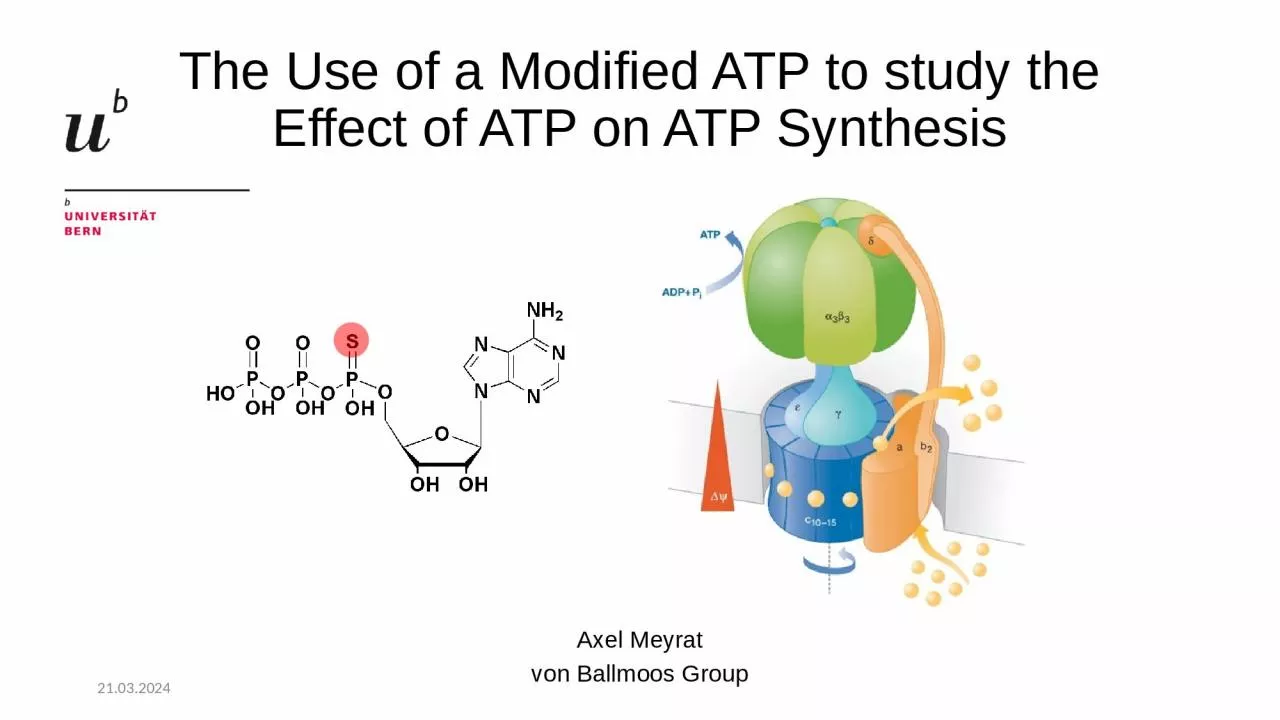

Effect of ATP on ATP Synthesis Axel Meyrat von Ballmoos Group 28092016 Oxidative phosphorylation 28092016 28092016 ATP Synthases Binding Change Mechanism 28092016 Effect of ATP on the ATP synthesis rate ID: 1038413
Download Presentation The PPT/PDF document "The Use of a Modified ATP to study the" is the property of its rightful owner. Permission is granted to download and print the materials on this web site for personal, non-commercial use only, and to display it on your personal computer provided you do not modify the materials and that you retain all copyright notices contained in the materials. By downloading content from our website, you accept the terms of this agreement.
1. The Use of a Modified ATP to study the Effect of ATP on ATP SynthesisAxel Meyratvon Ballmoos Group28.09.2016
2. Oxidative phosphorylation28.09.2016
3. 28.09.2016ATP Synthase’s Binding Change Mechanism
4. 28.09.2016Effect of ATP on the ATP synthesis rateATP ADP + PiNothing happens spontaneously at equilibriumﺣﺣ
5. 28.09.2016Measure of the ATP concentration:the luciferin-luciferase assayLuciferin + ATP + O2 oxyluciferin + CO2 + AMP + diphosphate + lightLuciferase
6. 28.09.2016The luciferin-luciferase ATP synthesis assayLuciferinLuciferaseNo ATP must be presentE. coli inverted membrane vesicles
7. 28.09.2016αβγAdenosine-5’-O-(1-thiotriphosphate)
8. 28.09.2016Adenosine-5’-O-(1-thiotriphosphate)
9. 28.09.2016Luciferin-luciferase reactions with ATPαS yields 0.01% of the luminescence that would be produced with normal ATPMixing of industrial luciferin-luciferase reagent with different concentrations of ATP or ATPαS
10. 28.09.2016ATPαS can be hydrolyzed by the ATP synthaseKm = 5μMKm = 6μM
11. 28.09.2016Effect of ADP concentration on the ATP synthesis rate (no ATP present)Km = 11μM
12. 28.09.2016Effect of ATP concentration on the ATP synthesis rate (with 10mM phosphate)[ADP]=[ATP] (ATP/ADP=1)Growing E. coli physiological range
13. 28.09.201650μM ADP (variable ATP/ADP)pGrowing E. coli physiological range[ADP]=[ATP] (ATP/ADP=1)Effect of ATP concentration on the ATP synthesis rate (with 10mM phosphate)
14. 28.09.2016Effect of ATP concentration on the ATP synthesis rateConstant phosphorylation potentialPhosphate doesn’t seem to have an influence![ADP]=[ATP] (ATP/ADP=1)50μM ADP (variable ATP/ADP)
15. 28.09.2016Our method allows to study ATP synthesis in a simple in vitro system not involving radioactivityPhysiological concentration of ATP impacts the ATP synthesis rate in the luciferase assayThe ATP/ADP ratio has an important control on the E. coli ATP synthesis rate likely due to kinetic competition with the ATP hydrolysis reactionImplications in the binding change mechanismDiscussion
16. 28.09.2016Applying the method to mitochondrial ATP synthase in proteoliposomes or E. Coli membrane vesiclesApplying the method to ATP synthases only capable of synthesis (e.g. IF1 inhibition) to see whether hydrolysis competition is really the explanationOutlook
17. 28.09.2016AcknowledgementIBMMPeter BütikoferBern UniversityDCBChristoph von BallmoosLinda ÖjemyrOlivier BinerThomas SchickAndrea AmatiSimone GrafSandra SchärNicolas DolderAymar GanguinRoman Mahler
18. 28.09.2016Thank you for your attention